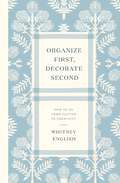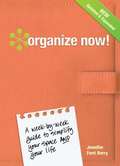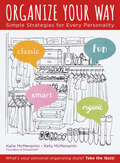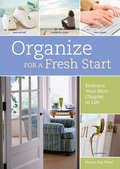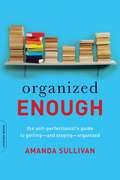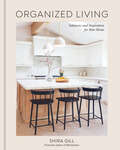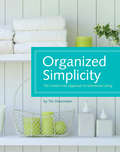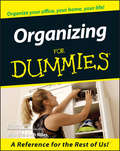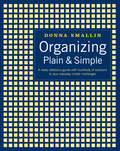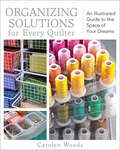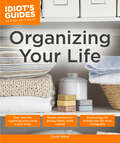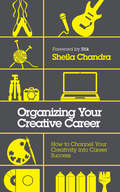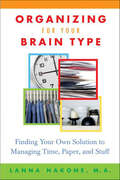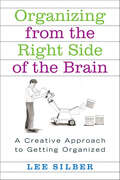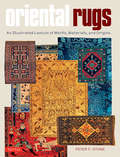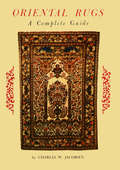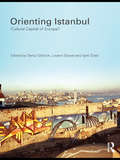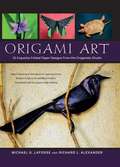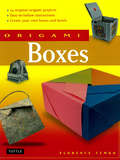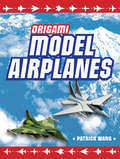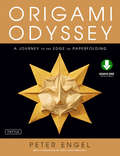- Table View
- List View
Organize First, Decorate Second: How to Go from Clutter to Creativity
by Thomas NelsonOrganize First, Decorate Second is the ultimate companion to help you embark on a transformative journey towards a more organized, beautiful, and fulfilling life. Whitney English breaks down the essence of thoughtful design and organization as tools not just for a prettier space but for a better life—one that smoothly adapts to the inevitable shifts we all face. She shares how balancing a neat look with functional living isn't always a walk in the park, but the payoff is a space that works just as hard as it charms.Whitney gets into the nitty-gritty with actionable strategies for putting the house in order. She walks readers through evaluating their spaces, marrying storage with style, and zoning rooms for peak performance. She even helps readers pick out furniture that doubles down on organization and gadgets that aren&’t just smart, but genius. Whitney underscores the significance of deliberate design and organization to enhance well-being and adapt seamlessly to life's ever-changing demands.Organize First, Decorate Second, establishes: balance between creativity and organization;inspiration coupled with practical advice; andefficiency without sacrificing creativity. With Whitney&’s guidance, practical tips, seasoned advice, and her signature humor, you&’re set to transform your living spaces into zones of beauty and effectiveness. Each chapter is a mix of heartwarming anecdotes, practical advice, and innovative strategies. This book isn&’t just about making your home look good—it&’s about making your home a reflection of your best self. Whitney doesn&’t just want you to organize, she wants you to celebrate each step, no matter how small, because perfection isn't the goal—it's all about the progress.
Organize Now!
by Jennifer Ford Berry Jacqueline MusserGet Organized Fast! Clutter has a cost. It steals your storage space, robs your time and energy, and takes away the peace and beauty of your home. Don't pay for it another minute-get organized, now! This updated and expanded edition of the bestselling Organize Now! features even more quick, effective organizing ideas. Easy-to-follow checklists show you how to organize any part of your life in less than one week. You spend more time organizing and less time reading-a perfect fit for your busy lifestyle! Long-term goals help keep the clutter away for the months and years to follow, so you can maintain the order you create. You'll find help with everything from time management and routines to mental clutter, paperwork, pets, purses, toys, rooms and life events such as moving and celebrating the holidays. Special money saving tips show you how to use your organizing efforts to cut costs around the house and even make a little money. Don't let piles of paperwork, overflowing closets and overbooked schedules drain your resources and energy anymore. Take control with Organize Now!
Organize Now! A Week-by-Week Guide to Simplify Your Space and Your Life (Revised Edition)
by Jennifer Ford BerryGet Organized Fast! Clutter has a cost. It steals your storage space, robs your time and energy, and takes away the peace and beauty of your home. Don't pay for it another minute-get organized, now!This updated and expanded edition of the bestselling Organize Now! features even more quick, effective organizing ideas. Easy-to-follow checklists show you how to organize any part of your life in less than one week. You spend more time organizing and less time reading-a perfect fit for your busy lifestyle! Long-term goals help keep the clutter away for the months and years to follow, so you can maintain the order you create. You'll find help with everything from time management and routines to mental clutter, paperwork, pets, purses, toys, rooms and life events such as moving, and celebrating the holidays. Special money saving tips show you how to use your organizing efforts to cut costs around the house and even make a little money. Don't let piles of paperwork, overflowing closets and overbooked schedules drain your resources and energy anymore. Take control with Organize Now!
Organize Your Way: Simple Strategies for Every Personality
by Katie McMenamin Kelly McMenaminStressing over the mess? Discover YOUR personal organizing style—and stay organized forever! Organization isn&’t one-size-fits-all. Different people need different solutions. Fortunately, Katie and Kelly McMenamin—the organizing gurus behind PixiesDidIt!®—have found the key to making organization stick, with strategies that work for every personality. Whether you&’re OCD or a little less fastidious, Katie and Kelly will help you discover your organizational style, using unconventional approaches or sticking to what already works. Along with personality-based solutions for every space in your home, they offer advice on solving strife between different &“PixieTypes.&” So you can keep the stuff you love . . . and the peace!
Organize for a Fresh Start: Embrace Your Next Chapter in Life
by Jacqueline Musser Susan Fay WestTRANSFORM YOUR HOME AND SCHEDULE so they perfectly meet your current needs and reflect who you are and what you value now. Changes and life transitions often leave people with unbalanced schedules and homes full of obsolete items. Certified Professional Organizer® Susan Fay West shows you how to make room for your new interests and responsibilities while honoring your past.Inside you'll find:Step-by-step advice for decluttering and reorganizing every room in the homeSpecific tips for where to start and how to stay motivatedReflective questions and exercises to help you make "no-regrets"decisionsTime-management strategies to create and maintain a regular schedule
Organized Enough: The Anti-Perfectionist's Guide to Getting--and Staying--Organized
by Amanda SullivanIf you're looking to clean up but not clean out, if you want to declutter but don't want to throw out eighty percent of your stuff, if you want to be able to find matching socks in the morning but don't want a color-coded sock drawer, you've come to the right place. Organized Enough offers a groundbreaking, science-driven method for getting--and staying--organized. Amanda Sullivan's proven approach will teach you the lifelong habits of the organized, showing you how to make cleaning up effortless and automatic. With seven concepts to help you define your goals and seven essential habits to keep chaos and clutter at bay, Organized Enough will teach you to reframe how you think about your space, your stuff, and your life. You'll learn how to:Sort the "stuff" from the sentimentalBecome a paper-filing ninjaCultivate consistency, not chaosSet up systems that can run on autopilotLet go of guilt and start enjoying your home...and more
Organized Living: Solutions and Inspiration for Your Home
by Shira GillGet inspired to level up your home organization with tips, Q&As, and photos of the living spaces of twenty-five international home organizers, from the author of Minimalista. Whenever people learn that Shira Gill is a professional home organizer, they always lean in and ask the same question: "So, is your home really that organized?" Spoiler alert: the answer is yes. Organized Living was inspired by Shira's desire to give others a glimpse into this rarely-seen world: The ultra-organized homes of people who organize others. There are plenty of books highlighting the spaces and stories of designers, entrepreneurs, and creatives; here, Shira showcases the homes of home organizers, from London to Lisbon, Paris to Portland, giving you an exclusive behind-the-scenes look into this meticulously kept world. Organized Living will introduce you to not only the aspirational spaces of the most organized people in the world, but also to the organizers themselves and the passion that fuels their work. Through images and interviews, you'll gain expert tips and resources, loads of visual inspiration, and clever organizing hacks you can use in your own home, such as: - Ditching the packaging - Choosing stylish storage- Elevating the most neglected spaces - Putting things away, right away People are naturally curious about the homes of professional organizers. With books, TV shows, and the arrival of viral and global celebrity organizer, Marie Kondo, home organizers have been elevated as top lifestyle influencers. Through blogs, podcasts, and social media platforms like Instagram, home organizers have further cemented their place in the cultural zeitgeist. And Shira Gill, the organizer of organizers, is the perfect tour guide to walk us through these professional organizers' homes featured in her latest book.
Organized Living: Solutions and Inspiration for Your Home [A Home Organization Book]
by Shira GillKickstart your organized life with this inspiring visual guide from the author of Minimalista.&“A fresh, global, and beautifully diverse perspective on calming the clutter.&”—Kelli Lamb, author of Home with Rue and editorial director of RuePeople are naturally curious about the homes of professional organizers. Organized Living was inspired by Shira's desire to provide a glimpse into a rarely-seen world: The homes of people who organize others. Shira showcases the homes of twenty-five international home organizers, offering an exclusive behind-the-scenes look into this meticulously kept world. Organized Living introduces you to the aspirational spaces of the most organized people in the world, the organizers themselves, and the passion that fuels their work. Through stunning images and absorbing interviews, you&’ll gain expert tips and resources, loads of visual inspiration, and clever organizing hacks you can use in your own home, such as:• Ditching the packaging• Choosing stylish storage• Elevating the most neglected spaces• Putting things away, right awayThrough books, TV shows, and social media platforms, home organizers have been elevated as top lifestyle influencers and have cemented their place in the cultural zeitgeist. And Shira Gill, the organizer of organizers, is the perfect tour guide to walk us through these professional organizers&’ homes.If you&’re seeking less clutter, overwhelm, and stress in your life, and are looking to create more time and energy for the things that matter most, Organized Living is your chance to learn directly from the best in the business.
Organized Simplicity: The Clutter-Free Approach to Intentional Living
by Tsh OxenreiderOrganized Simplicity's aim is to convince its readers that simple living is the absolute best way to live. Be it with house cleaning, family schedule management, personal finances, and managing the "stuff" you allow within your four walls, the only way to live well is to do so intentionally and simply. The first half of the book delves into the "why" behind realistic simple living, giving the reader a nail to then hang the how of living simply discussed in the second half. And by redefining the too often-used phrase "simple living," a busy home manager living in the real world can then make practical changes that work for the whole family. There are chapters for cleaning and organizing the home room-by-room, and future project ideas will inspire readers to turn their house in a haven they love.
Organizing For Dummies (For Dummies Ser.)
by Elizabeth Miles Eileen RothWhat’s the favorite four-letter word of people who are less than fully organized? “Help!” So many technological, social, and economic changes affect your life that you need organization just to keep up, let alone advance. Many people have two jobs – one at the office and one taking care of things at home. If you have a family, you may count that as a third job. Caring for elderly relatives or have community commitments? You can count off four, five, and keep right on going. No matter what life stage you’re in, getting organized can make every day better and help you achieve your long-term goals. Organizing For Dummies is for anyone who wants to Polish his or her professional reputation Experience less stress Increase productivity Build better relationships Maximize personal time Organization isn’t inherited. With the human genome decoded, the evidence is clear: DNA strings dedicated to putting things into place and managing your time like a pro are nonexistent. Instead, organization is a learned skill set. Organizing For Dummies helps you gain that skill with topics such as: Understanding how clutter costs you in time, money, and health Training your mind to be organized and developing a plan Cleaning house, room by room, from basement to attic (including the garage) Creating functional space for efficiency and storage Time-management strategies for home, office, and tavel Scheduling, delegating, and multitasking Making time for your family Managing your health – physical and financial Finding time for love Organizing and cashing in on a great garage sale Getting organized is about unstuffing your life, clearing out the dead weight in places from your closet to your calendar to your computer, and then installing systems that keep the good stuff in its place. Organizing is a liberating and enlightening experience that can enhance your effectiveness and lessen your stress every day – and it’s all yours simply for saying “No” to clutter.
Organizing Plain & Simple: A Ready Reference Guide with Hundreds of Solutions to Your Everyday Clutter Challenges
by Donna SmallinTake control of everyday disorder. With strategies for everything from keeping track of mittens and scarves to combining two households, Donna Smallin takes a personalized, nonjudgmental approach as she explains how to assess different situations and decide where to start organizing. Whether you’re craving a more functional closet, having trouble planning meals for your family, or trying to make sense of your finances, this straightforward guide offers proven techniques for living an efficient and clutter-free life. This publication conforms to the EPUB Accessibility specification at WCAG 2.0 Level AA.
Organizing Solutions for Every Quilter: An Illustrated Guide to the Space of Your Dreams
by Carolyn WoodsA professional organizer&’s handy guide to creating an uncluttered, inviting quilting space for yourself—whether it&’s a small closet or a large studio. This practical guide shows you how to organize and maintain your quilting space, no matter what size. Learn handy ways to sort and arrange all of your fabrics and supplies into easy-to-use stations—and find actual organizing solutions from quilters&’ studios, including Alex Anderson and Diana McClun. Create a calm and happy place for all your beloved fabrics, books, notions, tools, and even UFOs (unfinished objects). With colorful photos, you'll see real examples of what makes an efficient, functional, and inviting quilting space. You'll identify what's causing the clutter, learn how to turn it into a more creative zone, and find more time to do what you love—quilt!
Organizing Your Life: Practical Tips for Making Your Life More Manageable (Idiot's Guides)
by Cyndy AldredIn today's fast-paced, complex society, it's crucial to find ways to simplify, get organized, and increase productivity. Using dozens of beautiful, full-color photos, Idiot's Guides: Organizing Your Life presents a variety of ideas and steps for organizing every closet, drawer, room, and garage. In addition, ideas for organizing an office and electronic data, "green" aspects of organizing, and resources for people with clutter disorders are also included.
Organizing for Creative People: How to Channel the Chaos of Creativity into Career Success
by Shelia Chandra‘Sheila gave me the tools to hunt success, and the infrastructure to handle it when it came.’ Stik, world renowned street artist and author Most of the conventional ‘productivity’ advice you’ll find in the ‘soft business’ section simply does not work for creative people. Surprisingly, to date there has not been a single book that addresses the unique organizational challenges that artists face. This book sets out to change that, it addresses the myth that truly creative people are messy and that they need mess in order to create. Sheila Chandra applies her professional insights as a ‘creative’ and organizing expert to the lives of other busy creative people in all disciplines – showing them how good organization can liberate their creative ‘magic’. She begins with artists’ physical spaces, including arranging their workspaces and offices so that they remain tidy effortlessly. Her career ‘headspace’ chapters cover: • creative well-being, including artist support systems • career well-being, including networking and collaborations • self-promotion and how to avoid working for free • making social media pay • personal branding, career planning and goals • how to manage copyright issues and legal paperwork • legacy management And all from an artist’s point of view. These fool-proof, tried and tested systems are mixed with creativity tips and artist well-being advice that only one artist knows to give another. Written with real affection for the reader, Sheila Chandra takes the creative person by the hand and puts them on the path to success.
Organizing for Your Brain Type: Finding Your Own Solution to Managing Time, Paper, and Stuff
by Lanna Nakone Arlene TaylorAn astute, fun guide to organizing that offers tailored and specific advice-that actually works-on how to get and stay organized. Based on Lanna Nakone's experience as a professional organizer and the science of brain function, this engaging, practical book begins with a fun quiz so readers can determine which of the four distinct thinking and organizing types they display: - Maintaining Style (routine) - Prioritizing Style (logical) - Harmonizing Style (interconnected) - Innovating Style (creative). Then, matching their brain type with a custom profile of maintainable organizing routines, readers will be able to effectively tackle the stacks of paper, poorly managed time, and clutter in their homes and offices. Readers will also gain insight into the other brain types and how each type can best work with and understand the others. Organizing for Your Brain Type turns the task of managing life into an enjoyable experience.
Organizing for Your Brain Type: Finding Your Own Solution to Managing Time, Paper, and Stuff
by Lanna NakoneDiscover which organizing techniques work best for your thinking style—and make it easier to gain control of your environment! Drawing on the science of brain function and her experience as a professional organizer, Lanna Nakone offers tailored and specific advice that will actually work to help you tame your desk, unclutter your closet, manage your time, and save your sanity. Take the Brain Style quiz to determine which of the four parts of the brain you rely on the most to process information, and which organizing style complements your brain function. If you rely on the: Posterior left section of your brain, you&’re a Maintaining Style. You develop and follow routines well and adhere to traditional organizing methods. Frontal right section of your brain, you&’re an Innovating Style. Artistically creative, you have a unique stacking system that no one else understands. Posterior right section of your brain, you&’re a Harmonizing Style. Valuing interconnectedness with your family or coworkers, you need to be organized enough to keep your environment peaceful. Frontal left section of your brain, you&’re a Prioritizing Style. Adept at analyzing data, you prefer to delegate organizing. Chapters specific to each type offer practical tips and strategies for implementing an organizing system, maintaining your system, and coexisting with different brain styles. Insightful and understanding, Organizing for Your Brain Type turns the task of managing your life into an enjoyable experience. Chapters specific to each type offer practical tips and strategies for implementing an organizing system, maintaining your system, and coexisting with different brain styles. Insightful and understanding, Organizing for Your Brain Type turns the task of managing your life into an enjoyable experience.
Organizing for the Rest of Us: 100 Realistic Strategies to Keep Any House Under Control
by Dana K. WhiteSo you want to keep your kitchen counter clean but you aren't ready to toss the toaster? You want to be able to find your kids' socks but aren't looking to spend your 401(k) on clear bins? You long for a little more peace but minimalism isn't sparking joy? Decluttering expert and self-proclaimed recovering slob Dana K. White offers sustainable ideas to simplify and manage your home in Organizing for the Rest of Us.Traditional organizing advice never worked for Dana K. White. Is it possible, she wondered, to get organized without color coding my sock drawer? As Dana let go of the need for perfection, she discovered the joy of having an organized house in the midst of everyday life.In Organizing for the Rest of Us, Dana teaches us how to make great strides with minimal effort in organizing every room of our home. Here she offers 100 organizing tips to help us understand:Why changing how we think about clutter is the first step to getting rid of itThe basics of organization for people who don't like to organizeWhy you need to get a grip on laundry and dishes before getting organizedHow living with less clutter is better for the environment, our spiritual lives, and our relationshipsWhy real-life decluttering requires fewer hours and less emotional bandwidth than we imaginedOrganizing for the Rest of Us includes colorful photos, a presentation page, and a ribbon marker, making it a thoughtful gift or self-purchase for anyone:Doing spring cleaningMaking New Year's goalsDownsizing their own home or their parents' homeDecluttering and organizing for their own peace of mindFans of Dana's podcast, A Slob Comes Clean, which has been downloaded 9 million times, will treasure this book as a resource. With her lighthearted approach, Dana provides bite-size workable solutions to break through every organizational struggle you have--for good!
Organizing from the Right Side of the Brain: A Creative Approach to Getting Organized
by Lee Silber“If you’ve been fighting a lifelong and losing battle to get rid of the clutter, Silber’s sprightly and thorough advice could be the answer.” —Publishers WeeklyAlmost all the organizing books on the market today target the “left-brainer” —people who are generally disciplined, neat, and analytical. But for those who are more creative and spontaneous rather than logical and detail-oriented, help is on the way! In this book, Lee Silber turns traditional organizing advice on its head and offers unique solutions that complement the unorthodox lifestyle of the creative “right-brainer.”For example:* Discover how right-brainers can be organized in a left-brain world* Overcome obstacles that stand in the way of being more organized* Pile, don’t file—put paper in its place the right-brained way* Learn how being a pack rat can be a good thing, and more
Oriental Rugs
by Peter F. StoneThis monumental reference work--long awaited by collectors and scholars--fills an important gap in the available literature on oriental rugs. Lavishly illustrated with over 1000 photographs and drawings, it offers clear and precise definitions for the rug and textile terms in use across a broad swath of the globe--from Morocco to Turkey, Persia, the Caucasus region, Central Asia, Afghanistan, Pakistan, India and China. Covering priceless museum-quality rug traditions as well as modern centers of production, Oriental Rugs draws on classical scholarship as well as current terminology in use among producers and traders in these areas today. It focuses primarily on the rich hand-knotting and hand-weaving traditions of the Near East and Central Asia, but also includes some examples of Scandinavian and Native American weavings.Rugs are receiving ever-increasing attention and recognition in the field of art history. Tribal weavings especially have become a focus for new research, and Oriental Rugs provides a new understanding of many distinctive traditions that were previously understudied, such as the weavings of southwest Persia, Baluchistan and Kurdistan. A concise reference, this volume is a must-have for serious collectors and scholars.
Oriental Rugs a Complete Guide
by Charles W. JacobsenThis authoritative reference contains a vast amount of information about Oriental rugs.<P><P>Oriental Rugs: A Complete Guide is the first large volume on the subject to be printed in the past forty-five years is meant for the individual who is interested in purchasing his first Oriental Rug, as well as the collector, museum, and rug importer.The volume is divided into three main parts. Part I, entitled "General Discussion devotes one chapter to each of the large rug weaving countries and includes helpful hints as to what the rug buyer should look for in an particular rug.Part II, "Description of Types," is an alphabetical list of all the names that have been used to identify rugs in the past, as well as the names that are being used at present. Each entry is followed by a full discussion and description of the rug.Part III, "Plates," contains 194 pictures of different types of rugs, complete with descriptive captions for each. Thirty-nine of the plates are in full color. All of the plates are large, allowing the reader to see the design, and in some cases, the colors used in the particular rug.
Orienting Istanbul: Cultural Capital of Europe? (Planning, History and Environment Series)
by Deniz GöktürkLooking at the globalization, urban regeneration, arts events and cultural spectacles, this book considers a city not until now included in the global city debate. Divided into five parts, each preceded by an editorial introduction, this book is an interdisciplinary study of an iconic city, a city facing conflicting social, political and cultural pressures in its search for a place in Europe and on the world stage in the twenty-first century.
Origami Art
by Richard L. Alexander Michael G. LafosseOrigami Art is a unique new collection of origami projects featuring folding instructions for 15 complex origami models. Intricate, compelling and often lifelike, LaFosse's origami projects amaze and astound. Included here are such wonders as the American Alligator, Pond Turtles, Monk Seal, Malaysian Birdwing Butterfly and the Munich Orchid, among others.Also featured are articles on paper selection and preparation for each project; advanced techniques, such as "wetfolding" and compound origami plant design and construction. LaFosse embraces every aspect of this fascinating art form in his newest book and presents it brilliantly for advanced paper folders and the artist in us all.
Origami Boxes
by Florence TemkoOrigami is the ideal craft for anyone who likes to create with their hands. The projects in this book can help you express your creativity by folding wonderful containers out of single sheets of paper, perfect for gift-giving or display around the house. Origami Boxesfeatures designs for 24 boxes that range from traditional to unique, including a Row of Boxes, Round Bowl, and Triangle Gift Box created by origami expert Florence Temko.Each box is explained with easy to follow diagrams and illustrated with a photograph of the finished project. A section on folding techniques makes it easy to get started, with special tips on how to adapt boxes to different sizes and papers. This book is sure to provide hours of entertainment for both children and adults.
Origami Model Airplanes
by Patrick WangNow you can create amazingly detailed model airplanes using basic origami techniques! Have you ever marveled at the intricate design work of a model plane? Or dreamed about making one, but been intimidated by the long and complicated directions? If so, then Origami Model Airplanes is the book for you!Expert folder Patrick Wang provides illustrated instructions for 23 original paper airplanes. Not only has he created designs for truly eye-catching paper planes, he's also devised a unique system for making them that is less time consuming and frustrating, even for absolute newcomers to the art of paperfolding. Experienced folders will marvel that the most realistic model airplanes available today can be made using just familiar origami methods. In addition to multiple photos of the finished fighter jet models and other military planes, numerous facts are given for each of the planes these models so realistically depict.Take a chance with Origami Model Airplanes and prepare to stupefy and impress all who see them. No one will ever believe these intricate-looking model airplanes take just a nimble set of fingers, a pair of scissors and a bit of glue to make.
Origami Odyssey
by Peter Engel Nondita Correa-MehrotraRenowned origami artist Peter Engel first astounded origami enthusiasts and the lay person alike with his popular Origami from Angelfish to Zen. Since that book, published in 1989, Engel has gone through a personal change in his philosophy of origami design, honed through decades of elevating what is often viewed as simple paper folding into a fine art.In Origami Odyssey, Engel takes paper crafters on a journey to the edge of paper folding, providing instruction for exquisite and original origami designs, including several that have been shown in galleries and museums throughout the world. Experienced folders will delight in the chance to grow as artists as they master the projects in this book, and new comers to origami will find the author's journey so inspiring that they'll be ready to begin an odyssey of their own.This unique do-it-yourself paper craft book includes:Full-colored photos and step-by-step instructions and diagrams21 fun-to-do projects like the Green Horned Owl, Gingko Leaf, Stingray and much more!Downloadable material included
